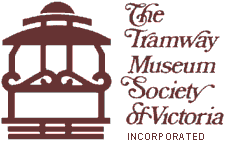
| About TMSV | Visitor information | Our collections |
Current projects | Feature articles | Join TMSV | Useful links | TMSV news |
 |
|||||||||
|
|||||||||
Victoria’s tramway heritageTramways have made a tremendous impact on the development of Melbourne as a great city, the results of which continue to resonate today. These influences are also apparent in a lesser extent in the provincial cities of Geelong, Ballarat and Bendigo. The development of the cable tram system during the period of ‘Marvellous’ Melbourne in the 1880s was an essential part of the development of the city as one of the great Victorian cities of the world, fuelled by the wealth generated by gold. The development of the cable tram system was driven by two men in particular — Francis Boardman Clapp and George Smith Duncan. The cable trams encouraged the development of the central business district, by providing cheap public transport for the emergent commuting middle class. Cheap public transport also made the development of the first skyscrapers with hydraulic powered lifts in Melbourne by encouraging growth in CBD property values. The cable trams also reduced the needs of the working classes to live adjacent to their workplace, which further increased the stratification of Melbourne suburbs due to greater worker mobility. The development of the CBD, particularly the great department stores such as Myer, Ball & Welch, Buckley & Nunn, and others was enabled by the construction of the cable tram system, which in its day was the largest in the world. The development of the first major suburban strip shopping streets, such as Chapel and Lygon Streets, was also driven by the introduction of the cable trams. Cable trams also had a great effect on Melbourne’s cultural and sporting life. The development of Bourke Street as the entertainment hub of Melbourne would not have been possible. Similarly, the founding of the Victorian Football League (VFL) in 1897 was strongly influenced by the availability of cable tram transport to all the home grounds of the founding clubs. This was one of the major factors that influenced the original breakaway clubs to invite St Kilda into the VFL at a late stage during the set up period, due to the advantageous location of Junction Oval. Cable trams enabled massive crowd attendance at VFL matches, setting a tradition which continues to the current day. The success of the cable trams were their own undoing. They were so popular that the loadings they generated exceeded the capacity of cable tram technology, which drove the conversion to electric traction between the two World Wars.
The development of electric tramways commencing in the first decade of the twentieth city continued to influence the development of Melbourne, being the dominant influence (together with the new electric suburban railways) in the development of suburbs and shopping centres until the rise in private motor vehicle ownership in the 1950s. The tramways reached their height of patronage during the Second World War, when they laboured under tremendous pressure to provide transport in the face of fuel rationing and the demands of a war economy. The retention of the electric tramways in Melbourne during the post Second World War period from 1949 to 1970 was the achievement of a remarkable man, Major General Sir Robert Risson. He led the Melbourne & Metropolitan Tramways Board during this period when virtually every other city in Australia closed its tramways. Sir Robert faced entrenched media opposition and an unsympathetic State Government, skillfully defending the tramways against attack. During this period there was also major industrial trouble, culminating in the last jailing of a union official in Australia (Clarrie O’Shea) for industrial action. The appointment of Rupert Hamer as Premier led to a renaissance of tramways in Melbourne, with the first new trams for twenty years being built, together with the first extension to the system over that period. This has continued to the current time, despite the changes to the management of the tramways with the establishment of the MTA/PTC, and the subsequent privatization of Melbourne’s tramways under the Kennett government. This continuing history of the tram system in Melbourne has led the W class tram to being an internationally recognised symbol of our city.
|
![]() Last
updated 2
January 2002.
Last
updated 2
January 2002.
![]() Content
copyright © Russell
Jones 2001-3. Reproduced with permission.
Content
copyright © Russell
Jones 2001-3. Reproduced with permission.